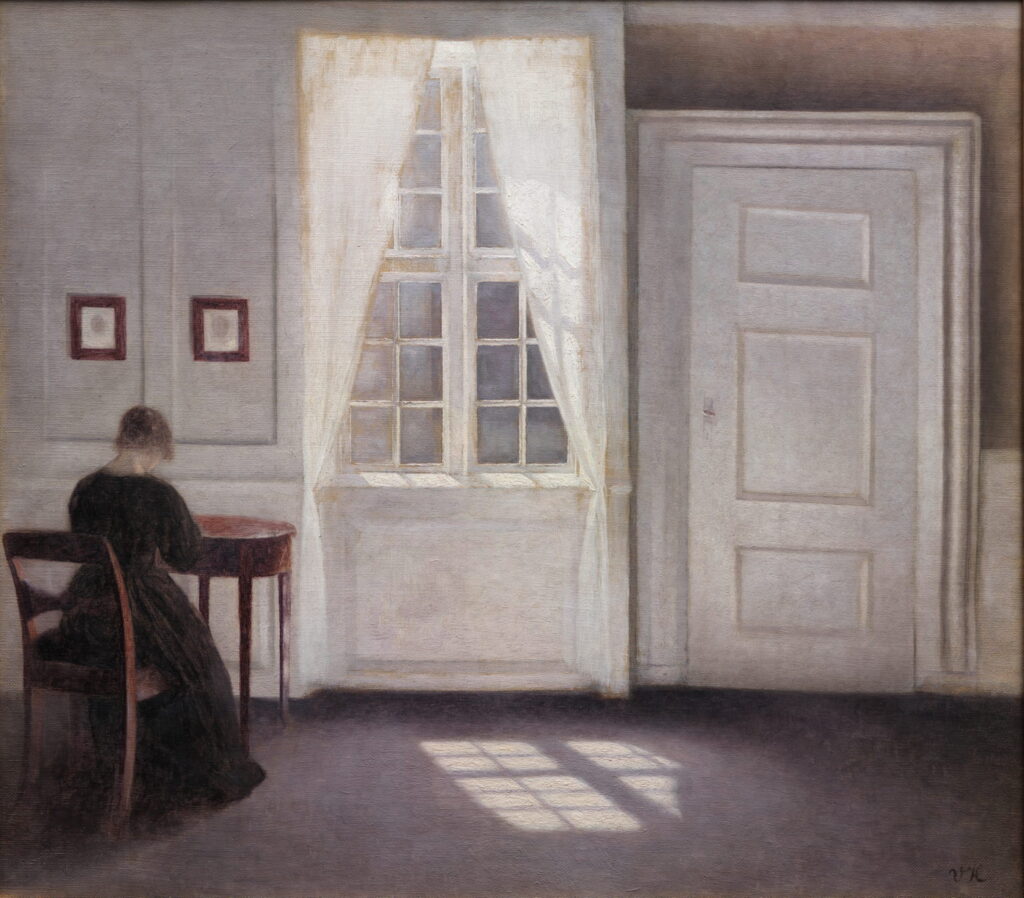Interiors by Design: The silence of Vilhelm Hammershøi

Over the last twenty years a Danish painter of interiors has become one of the best-known Nordic artists, thanks largely to a TV documentary aired in 2005, Michael Palin and the Mystery of Hammershoi. Like others of that time, Vilhelm Hammershøi had attained critical acclaim in life, then was rapidly obliterated in the rush to Modernism in the early twentieth century. Prices for his paintings have soared as he came into vogue over the last twenty years, and now normally exceed a million dollars, with one selling in 2018 for over five million.
As more have come to see his interiors, adjectives applied to them have become excessive or plain wrong. They have been described as recording the “banality of everyday life”, which they surely don’t, as “poetic” and “subdued”, “muted in tone”, and more. I’ll let you be the judge of his remarkable interiors.
Hammershøi was born in Copenhagen, capital of Denmark, in 1864, the son of a prosperous merchant. His younger brother Svend became an accomplished potter, and the two brothers remained close and worked together as business partners. Vilhelm had private art lessons from the age of eight, then studied at the Royal Danish Academy of Fine Arts, and with PS Krøyer (one of the prominent and successful Nordic Impressionists who met each summer at Skagen) until 1885, when he made his exhibition debut.
Until the closing years of the nineteenth century he mainly painted muted landscapes and portraits, then concentrated more on interiors. He and his wife Ida lived in an apartment at 30 Strandgade in Copenhagen between 1889-1910, where the majority of these interiors were painted.
Vilhelm Hammershøi (1864–1916), Interior in Louis Seize style. From the Artist’s Home. Rahbeks Allé (1897), oil on canvas, dimensions not known, Hirschsprung Collection, Copenhagen, Denmark. Wikimedia Commons.
His Interior in Louis Seize style. From the Artist’s Home. Rahbeks Allé was painted in 1897, when they were living in a more colourful apartment, although its colours are still muted, and the room empty apart from a few chairs, a small table and what may be a heater.
Vilhelm Hammershøi (1864–1916), Interior with a Bust (c 1900), oil on canvas, 53 x 42 cm, Private collection. Wikimedia Commons.
His Interior with a Bust from about 1900 is thought to show a corner of the dining room, where a bust could perhaps be intentionally misread as a figure playing a keyboard instrument.
Vilhelm Hammershøi (1864–1916), Interior with Ida in a White Chair (1900), oil on canvas, dimensions and location not known. Wikimedia Commons.
Interior with Ida in a White Chair, also from 1900, is one of many showing his wife Ida with her back to the viewer, and a recession of open doors. This room is also barren, and the chair familiar from his interior at Rahbeks Allé above.
Vilhelm Hammershøi (1864–1916), Interior with the Artist’s Wife Seen from Behind (1901), oil on canvas, 45 x 39 cm, Private collection. Wikimedia Commons.
Interior with the Artist’s Wife Seen from Behind (1901) is one of at least three similar views he painted that year showing his wife near their piano. Comparison with the others shows that he has simplified this version by omitting details of the wall panels, making it look even more spartan.
Vilhelm Hammershøi (1864–1916), A Room in the Artist’s Home in Strandgade, Copenhagen, with the Artist’s Wife (1901), oil on canvas, 46.5 x 52 cm, Statens Museum for Kunst (Den Kongelige Malerisamling), Copenhagen, Denmark. Wikimedia Commons.
Room in the Artist’s Home in Strandgade, Copenhagen, with the Artist’s Wife from 1901 is one of many in which Hammershøi explores the effects of light pouring in through the apartment’s windows. Two distinctive features of some of his other interiors are noticeable here: irregularity in details that would normally be rectilinear, such as the panels on the door, which look all ‘wonky’; soft focus in parts of the image that might appear similar to that famously used by Vermeer.
Vilhelm Hammershøi (1864–1916), The Collector of Coins (1904), oil on canvas, 89 x 69.5 cm, Nasjonalmuseet for kunst, arkitektur og design, Oslo, Norway. Wikimedia Commons.
Three years later, in 1904, Hammershøi painted The Collector of Coins lit by two candles, and apparently against the same window and door. There are subtle differences in detail, such as omission of mouldings on the wall at the left, but the addition of mouldings to the panel below the window. The door still looks wonky and, most unusually for his interiors, the figure faces the viewer even though he is looking down at his coins.
Vilhelm Hammershøi (1864–1916), Interior, Sunlight on the Floor (1906), oil on canvas, 44 x 51.8 cm, The National Gallery, London. Wikimedia Commons.
Interior, Sunlight on the Floor from 1906 returns to the same scene, this time without any figures and in higher contrast. The curtains have vanished, but that door looks wonkier than ever.
Vilhelm Hammershøi (1864–1916), Interior from the Home of the Artist (date not known), oil on canvas, 65.5 x 54.5 cm, Kansallisgalleria, Ateneum, Helsinki, Finland. Wikimedia Commons.
His undated Interior from the Home of the Artist also appears to have been painted inside the apartment at 30 Strandgade, this time with a recession of doors and fuller details of its wall decoration.
Vilhelm Hammershøi (1864–1916), Interior with Ida Playing the Piano (1910), oil on canvas, 76 x 61.5 cm, National Museum of Western Art 国立西洋美術館 (Kokuritsu seiyō bijutsukan), Tokyo, Japan. Wikimedia Commons.
The double doors in his Interior with Ida Playing the Piano from 1910 appear better aligned, as we look at the back of the artist’s wife as she’s seated at the piano in the next room. There’s more furniture here as well, and a deep metal plate on the table.
Vilhelm Hammershøi (1864–1916), Interior with the Artist’s Easel (1910), oil on canvas, 84 x 69 cm, Statens Museum for Kunst (Den Kongelige Malerisamling), Copenhagen, Denmark. Wikimedia Commons.
In some of his paintings his control of focus and edges is prominent, as in this Interior with the Artist’s Easel from 1910. Although the easel’s edges are soft, the sharpest focus here is on the distant bowl whose role isn’t clear.
In about 1910, the owner of the building in which Hammershøi and his wife were living evicted his tenants to undertake renovation. The Hammershøis appear to have moved to 25 Bredgade for a while, then on to 25 Strandgade in 1913.
Vilhelm Hammershøi (1864–1916), Interior with Potted Plant on Card Table, Bredgade 25 (1910-11), oil on canvas, 78.5 x 71 cm, Malmö konstmuseum, Malmö, Sweden. Wikimedia Commons.
His later interiors gathered additional objects and details, as seen in this Interior with Potted Plant on Card Table, Bredgade 25 from 1910-11. This appears to be the same view as Interior with the Artist’s Easel above, but with more furniture and the same bowl brought forward from the room behind, which is now just a white void.
Perhaps the best clues to Hammershøi’s intent are given in a quotation from an interview with the artist in 1907: “I’ve always thought there was such beauty about a room like that, even if there were no people in it, perhaps precisely when there were none.” Michael Palin surely gives the best advice in the closing words of his documentary: “I think the key to understanding Hammershøi is that he deliberately didn’t want us to know him. He was an artist. He made paintings. The rest is silence.”
Reference
Wikipedia in Danish



